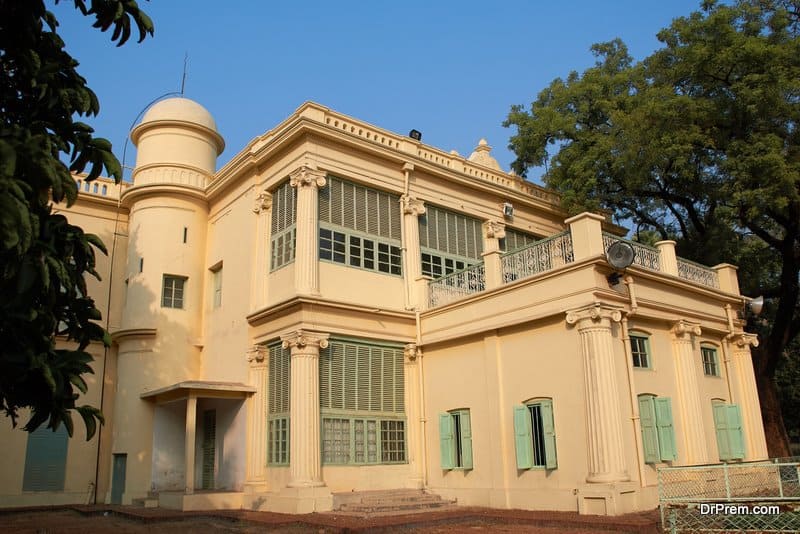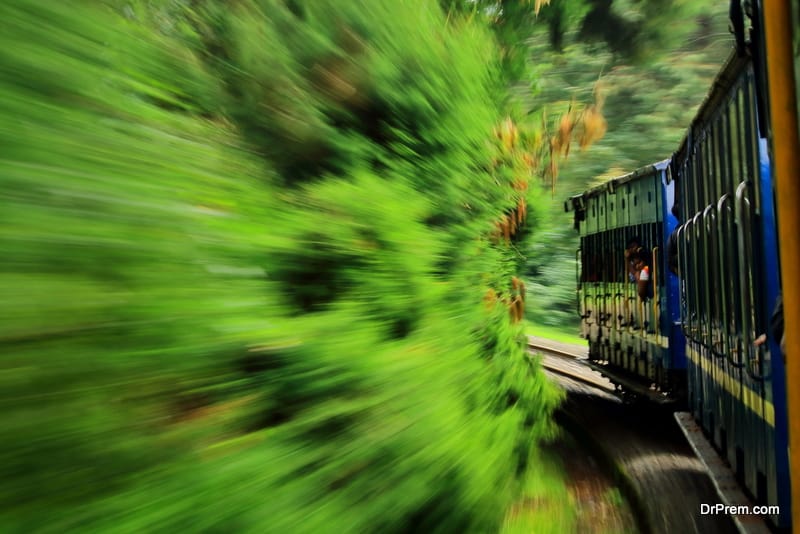ON THE RED SOILS OF SHANTINIKETAN
Indrani Mitra
Although renowned as the second home of our greatest of Bengali poets, with an international stature, Sri Rabindranath Tagore, Shantiniketan, as the name suggests is also visited for its majestic scenic beauty. Located about 120 km. from Kolkata, it is the destination for every artist whether they be poets, writers, painters, musicians, dancers, or nature lovers. Ganadebata Express leaving from the Howrah station at 7 a.m. in the morning can take you to this land of poetry.
This place was founded by Maharshi Debendranath Tagore, a member of the Brahmo Samaj, and the name stands for ‘the abode of peace’. Maharshi Debendranath Tagore, while working for the Brahmo Samaj visited the house of his disciple Srikontho Singha, at Raipur in Birbhum. On his way to the house of this disciple he came across a vast empty landscape with a few wild dates and palm trees growing in clusters. Maharshi rested in this place for a few moments during which he experienced an indescribable spiritual bliss. Immediately he purchased 20 bighas of land from the zamindar of Raipur on 1st of March, 1863. Thus, it was this date which laid the foundation of a second home, not only for Rabindranath, but for all the artists of forthcoming generations.
At the age of 12, when Rabindranath first visited Shantiniketan, he was enamoured by the natural beauty of this place and like his father he too had felt a spiritual value of this place. He felt his own soul at one with that of the nature’s, much in the fashion of the English Romantic poet, William Wordsworth, and composed a number of poems on this theme. As he grew up he came back to this place and founded the first open-air university of the world, Visvabharati University. There are open-air schools in this campus which not only trains students in academics, but also in cultural studies like dance, music and art.
Shantiniketan has various places of interest to visit. To start with there is the vast open space where a grand fair is organized every year towards the end of the month of December. It is popularly known as the ‘Poush Mela’. This is a time of grand celebration in Shantiniketan when tourists from all over the world visit this place. On 22nd of December, 1843, Maharshi Debendranath Tagore had enrolled as a disciple of the Brahmo Samaj. It is to commemorate this event that this fair is arranged. The special feature of this fair is its promotion of the folk culture, apart from the regular events which are a part of almost all fairs. The local art and artifacts along with their makers are all present at this occasion. Towards the northern side of the field where this fair is held, there is the Estate Office of Visvabharati in front of which stands the ‘Shantiniketan Press’. If you move up the Shantiniketan Road, what you come across is the Central Office of Shantiniketan towards the opposite of which is the Central Library, which opens at 7a.m. and closes at 8 in the evening. Apart from this library, every individual department has a library of its own. Just beside the Central Library, is the Public Relations Cell of the University. In front of this is the Philosophy and Comparative Theology Department, beside which stand the Boys’ Hostel and the Guest House.
‘Dijobiram’ was constructed by Rabindranath’s elder brother, Dijendranath Tagore. As the name suggests this place is exclusively for the rest of birds with a pool where the birds come to drink water. The Hindi Bhavan located towards the north of the second gate of the University was inaugurated by Pandit Jawaharlal Nehru. This Bhavan is well known for the incomparable beauty of the pictures painted on the wall by the famous Binod Bihari Mukhopadhyay. Here, a diploma to a doctorate is available in the Hindi language. The building next to this Bhavan is the Visvabharati Canteen. The ‘China Bhavan’ is yet another structure of wonder built with the help of Chiang Kaishek and Tan Yun Shan, an ex-professor of Shantiniketan. Rabindranath Tagore inaugurated this Bhavan on April, 1937. About 24,000 books were gifted by Mr. and Mrs. Kaishek to the library of this Bhavan, many of which are now quite rare and unquestionably invaluable. The ex-Prime Minister of China, Chow En Lai had further gifted this library with 36,000 books. On the walls of this Bhavan there are portraits and frescoes by Nandalal Basu and his students Sri Provash Sen, Sri Gouri Bhanja and Sri Satyajit Roy. Facing the China Bhavan is the building called ‘Santoshaloy’. This is the abode for students of classes 2 and 3. The Mukut Ghar in this building is a mud thatched room made by he students and is also used for holding classes. The ‘Amrakunja’ is a large garden of mangoes. The Annual Convocation of the University is held over here. Rabindranath himself had felicitated Sarat Chandra Chattopadhyay and Netaji Subhash Chandra Basu.
The actual Shantiniketan Building has to its north the famous Chatimtala and the Glass Prayer House where both Rabindranath and his father had attained their spirituality in their communion with God. It was this Chatimtala where Maharshi Debendranath had sat for his respite during his journey to Raipur many years before. ‘Pathabhavan’ is the school of academic education in Shantiniketan. This leads further to Uttarayan, a name with an epical significance. In The Mahabharata, on his bed of arrows, Bhisma had said that he would die when the sunrays would light up the north. Rabindranath wanted this building to be lighted up in a similar manner by the sun. There are five different houses where Rabindranath stayed during the various seasons of the year. Shyamali, Bichitra, Punoscho, Konark and Udichi are all located on various ends of the Uttarayan building. Each of these houses has an interesting history of their own which waits to be told to the tourists by the guide. It is in Bichitra that the museum called Rabindra Bhavan is situated. This museum has an exquisite collection of the various manuscripts, letters, portraits and self made drawings of Rabindranath. Mementoes from across the world which were received by the great poet, bulletins by him and concerning him are all present here. Even the wills, testaments and documents from the Tagore family can be found over here. Pictures and sculptures of Abanindranath Tagore, Gaganendranath Tagore, Nandalal Basu, Ramkinkor Beij and many more artists are preserved here. The gallery is decorated with articles used by Rabindranath such as his pens, books, dresses, shoes, etc. The car which was used by the Tagore family is also preserved with great care to the north-east end of the Bichitra Bhavan. Already a new museum is in planning owing to the ever increasing number of collections.
Moving a little forward from Uttarayan is the Kala Bhavan Art Gallery, inaugurated by the late Prime Minister of India, Smt. Indira Gandhi on 12th December, 1981. This also has a hostel for its students called the Black House. The ‘Natyaghar’ faces the art gallery and it is here that various performances are put up. Behind the Black House is the Sangeet Bhavan which has a fixed stage prepared for performance. There is also a Helipad to the left of the Girls’ Hostel, Madhabi. A swimming pool is present to the right of the Sangeet Bhavan. Here students are provided with swimming lessons.
An important aspect of Shantiniketan is that every season has a celebration over here with the songs of Rabindranath himself. These are regarded as Utsavs, such as the Basant Utsav, Sharad Utsav, Poush Utsav and so on.
A tour to Shantiniketan cannot be complete without a visit to Sriniketan. Rabindranath had founded this village along with the assistance of Leonard K. Elmhorst in 1922 with the purpose of social and economic upliftment of the backward sections of the society living here. Though started with only three villages of the Birbhum District, presently it has enrolled more than two hundred villages under it. Here the villagers create various pieces of art from wood, leather, silk, tant, and batik. Training in agriculture is also provided. This venture by Rabindranath Tagore actually shows us that he was not only a great literary figure, but also essentially a socialist and a humanist.
Shantiniketan has its own charms with its red soil, folk flavour, artistical creations and innovations, and, the great mind working behind it all!
For its extremes of temperature the ideal time to visit Shantiniketan is from the month of October to February. The local hotels and guest houses provide accommodation under reasonable rates, though provisions for luxury suites are always there. If you plan to visit this place during any of the Utsavs mentioned above, prior booking is necessary because often there is a dearth of accommodation facilities owing to its high demand.
Generally tourists tour around by walking, but private rickshaws and cabs are also available.
So what next! This Puja have a grand time at the most poetic spot on the face of the earth and experience the magnificent spiritual delight which Rabindranath Tagore and his father had felt hundreds of years before!!!!




